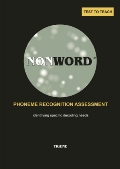NONWORD Phoneme Recognition Assessment

NONWORD
Catherine Parkin
© 2003 Triune Initiatives
PURPOSE
NONWORD, through the use of pseudo-words, provides an assessment to identify specific areas of decoding difficulty in students who are able to read but are still having difficulty with some words.NONWORD identifies those letter blends that a student either does not know, or is not able to recognize quickly enough for efficient reading.
This information provides the basis of a targeted teaching program.
1 BOOK
with two parallel pseudo-word assessments
FOR USE BY
specialists & classroom teachers
FOR USE WITH
8 yr olds - adults
SETTING
Individual
CONTENTS
• Manual – with Guide and 2 Copymasters
• Double-sided laminated card containing Student Lists A & B
KEY FEATURES
• Two separate, but parallel sets of 30 words
- which become progressively more difficult to decode.
• Notes to assist analysis of assessment and subsequent teaching plan.
• Suggested steps in a phoneme teaching plan.
• Avoids known sight words – ensuring active reading of phonemes.
• Can be used as a decoding or auditory recognition/oral ability assessment.
• Can isolate a student’s ability to:
- identify individual letters and their sounds in words
- identify the phonemic chunks
- join phonemic chunks
- recognise and use syllables
UNIQUE FEATURE
Identifies the specific phonemic chunks that are being targeted.
This enables a more precise teaching program to be developed.
RATIONALE
Decoding ability can be measured with a sight word recognition test. When an unknown word is presented, students will try to make sense of it because they know it is a real word, even if they don’t know what it is. However, while word recognition tests are useful tools for gathering data about a reader, they are not always enough to help understand what the student is seeing and what attack strategies they have for reading unknown words.

